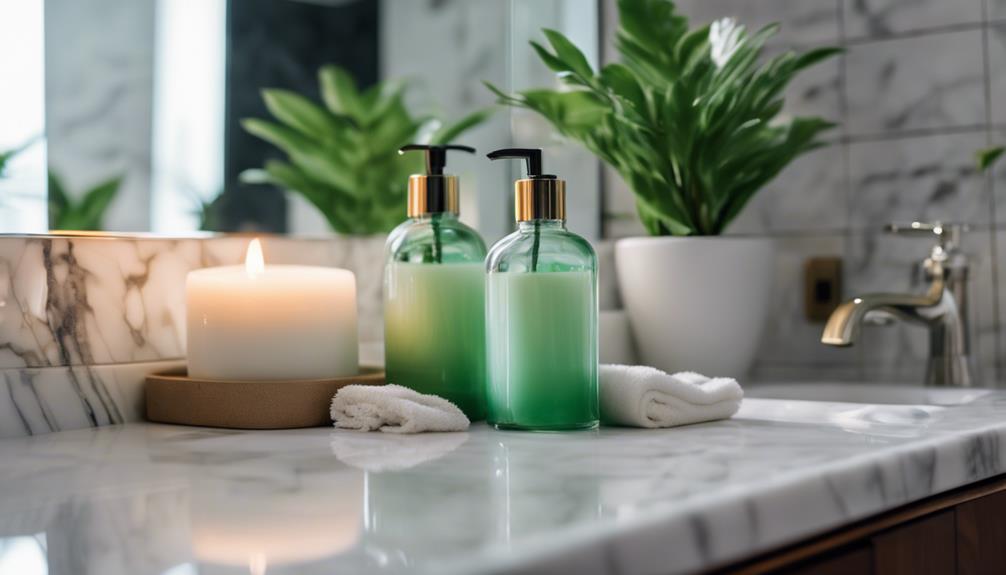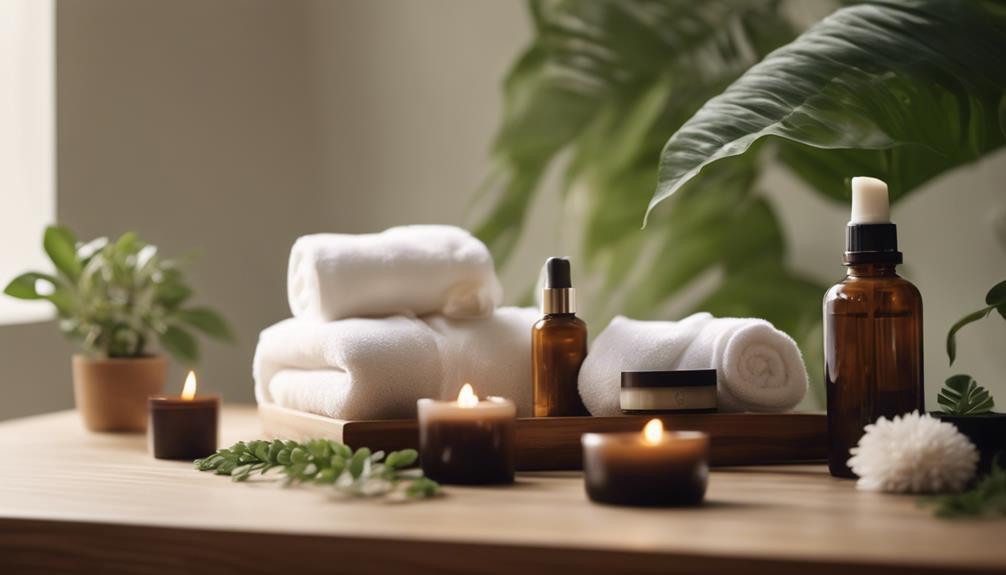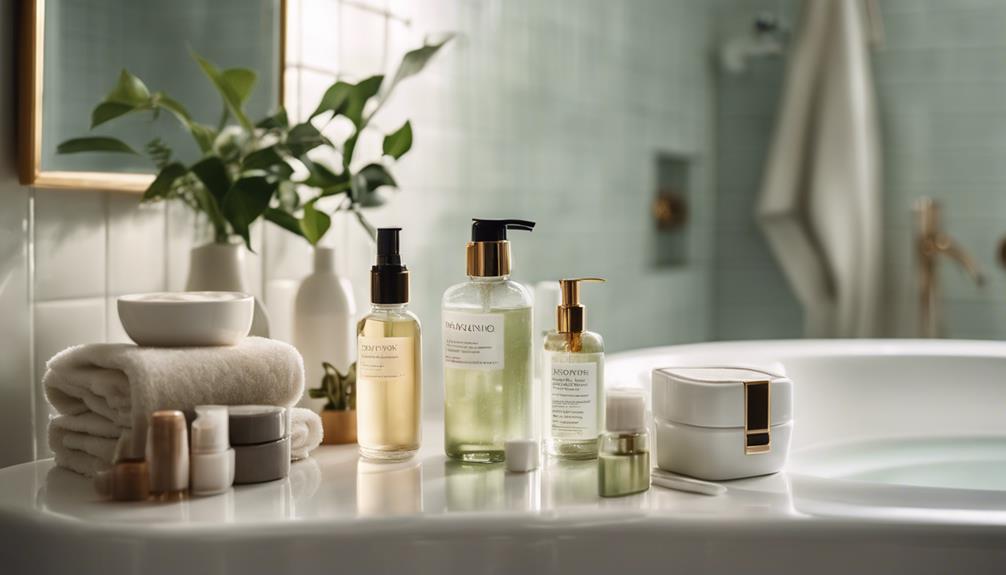To achieve a youthful glow, start with a gentle cleanser to remove impurities without stripping your skin. Follow up with a Vitamin C serum to boost collagen and brighten your complexion. Introduce retinol to promote cell turnover and diminish wrinkles. Don't forget to moisturize for hydration and elasticity, and always apply broad-spectrum sunscreen with at least SPF 30 to shield against UV damage. Consistency is key, so make this routine a daily habit. As you explore further, you'll discover tailored routines for your specific skin type that can enhance your results even more.
Key Takeaways
- Start your routine in your 30s with a gentle cleanser, vitamin C serum, moisturizer, and sunscreen for effective prevention of aging signs.
- Incorporate retinol into your nighttime routine to promote cell turnover and reduce wrinkles over time.
- Apply broad-spectrum sunscreen (SPF 30+) daily to protect against UV rays and prevent premature aging.
- Tailor your routine according to your skin type, using specific products suited for oily, dry, or combination skin.
Essential Anti-Aging Products
To effectively combat signs of aging, you need to incorporate essential products like a gentle cleanser, vitamin C serum, retinol, moisturizer, and broad-spectrum sunscreen into your daily skincare routine.
Start with a gentle cleanser to remove impurities without stripping your skin's natural oils. This prepares your skin to absorb the active ingredients that follow.
Next, a vitamin C serum is vital. It boosts collagen production, combats oxidative stress, and brightens your complexion, making it an essential anti-aging ingredient.
After applying your serum, use retinol to promote cell turnover, helping reduce wrinkles and fine lines. With consistent daily use, you'll likely see visible results within three months.
Don't forget to apply a well-rounded moisturizer. This not only guarantees skin hydration but can also include additional anti-aging ingredients that maintain skin elasticity as natural oil production decreases with age.
Finally, finish your routine with broad-spectrum sunscreen. Daily use of a sunscreen with at least SPF 30 protects your skin from harmful UVA and UVB rays, which greatly contribute to aging.
Key Ingredients to Look For

When choosing anti-aging skincare products, look for key ingredients that have proven benefits for enhancing skin health and appearance.
Vitamin C is a must-have; it boosts collagen production, fights oxidative stress, and brightens your skin, helping to reduce fine lines and dark spots.
Incorporating a retinol serum can also work wonders by promoting skin cell turnover and reducing the appearance of wrinkles, typically showing results within three months.
Don't forget about hyaluronic acid—this powerful humectant holds up to 1,000 times its weight in water, guaranteeing your skin stays hydrated and plump.
For added elasticity and firmness, seek out peptides; they signal your skin to produce more collagen, promoting a youthful appearance.
Additionally, consider products with niacinamide, which strengthens the skin barrier, improves texture, and reduces inflammation, making it ideal for sensitive skin.
Lastly, make sure your routine includes moisturizing ingredients that keep your skin nourished and supple.
Daily Sunscreen Importance

You can't underestimate the importance of daily sunscreen in your anti-aging routine. It shields your skin from harmful UV rays that cause premature aging and promotes a consistent application habit for maximum protection.
With various types of sunscreens available, finding the right one for you is essential to keep your skin looking youthful.
UV Protection Necessity
Daily sunscreen application is essential because it protects your skin from harmful UV rays that can lead to premature aging and increase the risk of skin cancer.
UVA rays penetrate deeply and accelerate skin aging by causing wrinkles and dark spots, while UVB rays are responsible for painful sunburns. To effectively shield your skin, choose a broad-spectrum sunscreen with at least SPF 30. This level of UV protection is vital for reducing the risk of skin cancers, as over 90% of nonmelanoma skin cancers are linked to UV exposure.
It's important to remember that UV rays can still reach you on cloudy days or even indoors, so daily sunscreen use should be a non-negotiable part of your routine.
Reapplying sunscreen every two hours—or more frequently if you're swimming or sweating—ensures that your skin remains protected throughout the day.
Prioritizing this step not only helps maintain your skin's youthful appearance but also greatly lowers your risk of skin cancers. Make daily sunscreen application a habit, and give your skin the protection it deserves.
Consistent Application Benefits
Regularly applying sunscreen isn't just about protection; it also plays a key role in maintaining your skin's health and appearance over time. By incorporating sunscreen into your daily skincare routine, you're not just protecting your skin from harmful UVA rays, but you're also supporting your anti-aging efforts. Consistent use of broad-spectrum sunscreen with at least SPF 30 helps to preserve your moisture barrier and keeps your skin looking young by preventing the breakdown of collagen and elastin.
Here's a quick overview of the benefits of daily sunscreen application:
| Benefit | Explanation | Result |
|---|---|---|
| Protects Against UV Rays | Shields skin from harmful rays that cause aging | Reduces signs of aging |
| Reduces Skin Cancer Risk | Daily use can lower the likelihood of melanoma | Long-term skin health |
| Enhances Other Products | Complements anti-aging products by preventing damage | Maximizes skincare results |
| Maintains Moisture Barrier | Helps retain skin's hydration | Keeps skin healthy and plump |
Make certain to reapply every two hours, especially after sweating or swimming, to guarantee you continue to protect your skin effectively.
Types of Sunscreens
Choosing the right type of sunscreen is essential for effective daily protection against harmful UV rays and maintaining youthful skin. Daily sunscreen shields you from UVA and UVB rays that lead to aging concerns, like fine lines and pigmentation.
Here are three types of sunscreens to take into account:
- Chemical Sunscreens: These contain organic compounds that absorb UV radiation. They're lightweight and great under makeup but need to be applied generously and allowed to absorb before sun exposure.
- Physical (Mineral) Sunscreens: Formulated with zinc oxide or titanium dioxide, these sit on the skin's surface and reflect UV rays. They're ideal for sensitive skin and provide immediate protection, but you should still reapply sunscreen every two hours.
- Tinted Sunscreens: Combining sun protection with a hint of color, tinted sunscreens can help even out skin tone while protecting against UV rays. They're particularly effective for rehydrating skin and addressing minor imperfections.
Whichever type you choose, remember to apply generously and reapply sunscreen regularly to maintain ideal protection throughout the day. Your skin will thank you!
Starting Your Anti-Aging Routine

Starting your anti-aging routine in your 30s can markedly help prevent visible signs of aging and keep your skin looking youthful.
To kick things off, focus on a basic anti-aging skincare routine that includes a gentle cleanser, vitamin C serum, moisturizer, and broad-spectrum sunscreen. These essentials will help keep your skin hydrated and protect it from environmental damage.
As you begin, it's important to introduce new products gradually. This allows your skin to adjust and lets you identify what works best based on your unique skin type.
Don't be alarmed if you experience some initial purging; it's often a positive sign that the products are taking effect.
Holistic Skincare Approach

A holistic skincare approach recognizes that your skin's health is deeply intertwined with your overall well-being, emphasizing the importance of a balanced lifestyle to achieve a radiant complexion.
To effectively maintain your skin and combat aging, consider incorporating these key elements into your routine:
- Nutrition: Focus on a balanced diet rich in antioxidants, such as vitamin C, to help improve skin texture and tone. Ingredients like berries, nuts, and leafy greens can work wonders for your complexion.
- Hydration: Adequate hydration is essential. Drinking enough water helps maintain your skin's elasticity and prevents dryness, critical for reducing the appearance of aging.
- Rest and Relaxation: Prioritize quality sleep to allow for cellular repair and regeneration. Additionally, managing stress through mindfulness or relaxation techniques can prevent skin issues like wrinkles and inflammation.
Avoid harmful lifestyle choices, such as smoking and excessive alcohol consumption, as they can compromise your skin's health.
Tailored Routines for Skin Types

When it comes to anti-aging, your skincare routine should match your specific skin type.
If you have oily skin, you'll want to focus on oil-free solutions.
On the other hand, dry skin calls for rich hydrators.
Combination skin needs a balanced approach, so let's explore the best strategies for each type.
Oily Skin Solutions
For oily skin types, a tailored skincare routine that balances hydration and oil control is essential to achieve a healthy, radiant complexion. Focusing on specific products can help you manage excess oil while addressing anti-aging concerns.
Here's a simple routine to follow:
- Cleanser: Start with a gentle foaming cleanser containing salicylic acid to reduce excess oil and prevent breakouts without stripping essential moisture.
- Toner: Use a toner with witch hazel or glycolic acid to refine pores and control oil production. This preps your skin for the next steps in your regimen.
- Moisturizer: Opt for a lightweight, oil-free moisturizer infused with hyaluronic acid to hydrate your skin without clogging pores.
Incorporate a retinol product to promote cell turnover and reduce the appearance of fine lines while managing oiliness.
Don't forget to apply a broad-spectrum sunscreen with a matte finish daily. This helps protect your skin from damage and supports collagen production, making your anti-aging regimen even more effective.
Dry Skin Remedies
To effectively combat dry skin, you'll want to create a routine that emphasizes hydration and barrier protection. Start with a hydrating facial cleanser that contains ceramides and hyaluronic acid, ensuring you cleanse without stripping your skin's natural oils. Follow up with a rich moisturizer that includes ingredients like glycerin or squalane to build a protective barrier, locking in hydration all day.
Incorporate serums that include hyaluronic acid and peptides to attract moisture and enhance your skin's texture. Additionally, consider using a humidifier in your living space to prevent skin from drying out, particularly during colder months.
Don't forget to protect your skin! Regularly apply broad-spectrum sunscreen with SPF 30 or higher. This shields your skin from UV damage, which can worsen dryness and accelerate aging.
Here's a quick reference table to help you:
| Step | Recommended Product |
|---|---|
| Cleanser | Hydrating facial cleanser |
| Moisturizer | Rich moisturizer with glycerin or squalane |
| Serum | Serums that include hyaluronic acid & peptides |
Combination Skin Strategies
Steering through the complexities of combination skin requires a tailored routine that addresses both dry and oily areas effectively.
Here's a simple guide to optimize your anti-aging regimen:
- Start with a gentle cleanser: Use a hydrating facial cleanser that contains ceramides and hyaluronic acid. This will remove impurities without stripping essential moisture.
- Incorporate targeted serums: Apply a vitamin C serum for its brightening benefits during the day and a retinol formulation at night to combat fine lines. Alternate these serums to minimize irritation.
- Moisturize wisely: Choose an oil-free moisturizer with non-comedogenic ingredients. This keeps your skin hydrated without exacerbating oiliness in certain areas.
Don't forget about regular exfoliation! Opt for chemical exfoliants like glycolic or salicylic acid to balance your skin while avoiding irritation.
Finally, always finish your morning routine with a broad-spectrum sunscreen with at least SPF 30 to protect against UV damage, which accelerates aging signs.
Frequently Asked Questions
What Is the Best Anti-Aging Skincare Routine?
To combat aging, you should cleanse your skin, apply vitamin C in the morning, use retinol at night, moisturize, and always wear sunscreen. Consistency over three months can reveal significant improvements in your skin's appearance.
In What Order Should You Use Anti-Aging Skin Products?
You'll feel like you've discovered the fountain of youth when you apply your anti-aging products in this order: cleanse, vitamin C serum, moisturizer, sunscreen in the morning; cleanse, retinol, and nourishing moisturizer at night.
What Do I Need for Anti-Aging Skin Care?
For effective anti-aging skincare, you need a gentle cleanser, vitamin C serum, retinol, moisturizer, and broad-spectrum sunscreen. These essentials nourish your skin, boost collagen, and protect against damage, ensuring a youthful complexion.
What Is the Dermatologist Anti-Aging Regimen?
Think of your skin like a garden; a dermatologist's anti-aging regimen nurtures it with a gentle cleanser, antioxidant serum, retinol, moisturizer, and sunscreen. Together, these elements help rejuvenate and protect your skin effectively.
Can the Anti-Aging Skincare Routine Help with Acne Prevention?
Yes, a dermatologistapproved acne treatment tips can be incorporated into an anti-aging skincare routine to help prevent acne. Utilizing non-comedogenic products and regularly exfoliating can keep pores clear, while using anti-aging ingredients like retinoids can reduce acne and fine lines simultaneously. Consistency is key for best results.
Conclusion
You might think an anti-aging routine is just for those with fine lines or wrinkles, but it's really about prevention and maintaining healthy skin at any age.
By starting now, you give your skin the best chance to stay youthful and vibrant.
Embrace the essential products, key ingredients, and daily sunscreen as part of your holistic approach.
Tailoring your routine to your skin type guarantees you're not just fighting signs of aging, but celebrating your skin's unique beauty.









